Bagamoyo
Bagamoyo, Tanzania, is a town founded at the end of the 18th century, though it is an extension of a much older (8th century) settlement, Kaole. It was the capital of German East Africa and was one of the most important trading ports along the East African coast along the west of the Indian Ocean. In 2011, the town had 82,578 [1] inhabitants and is the capital of the Bagamoyo District.
Bagamoyo | |
|---|---|
 The German Boma. | |
 Bagamoyo Location of Bagamoyo  Bagamoyo Bagamoyo (Africa) .svg.png) Bagamoyo Bagamoyo (Earth) | |
| Coordinates: 6°26′40″S 38°54′10″E | |
| Country | Tanzania |
| Region | Pwani Region |
| Population (2011) | |
| • Total | 82,578 |
| Time zone | UTC+3 (East Africa Time) |
| Area code(s) | 023 |
| Climate | Aw |
| Website | Regional Website |
Location
Bagamoyo is located at 6°26′S 38°54′E. It lies 75 kilometres (47 miles) north of Dar-es-Salaam on the coast of the Indian Ocean, across from the island of Zanzibar.
History
The original settlement, Kaole, was founded c. 800 CE, and grew into an important trading town by the 13th century. The Kaole Ruins contain the remnants of two mosques and 30 tombs, dated back to the 13th century. Around the 17th century, the settlement 2–3 miles north of Kaole began growing. This area grew in prosperity, acquiring the name Bagamoyo by the 18th century as an important stop in the caravan trade (the name means "take the load off and rest"). Until the 18th century, Bagamoyo was a small trading center where most of the population were fishermen and farmers. The main trading goods were fish, salt, and gum, among other things.[2] Bagamoyo became the most important trading entrepot of the east central coast of Africa in the late 19th century.
In the late 18th century, Muslim families settled in Bagamoyo, all of which were relatives of Shamvi la Magimba in Oman. They made their living by enforcing taxes on the native population and by trading in salt, gathered from the Nunge coast north of Bagamoyo. In the first half of the 19th century, Bagamoyo became a trading port for ivory and the slave trade, with traders coming from the African interior, from places as far as Morogoro, Lake Tanganyika and Usambara on their way to Zanzibar. This explains the meaning of the word Bagamoyo ("Bwaga-Moyo") which means "Lay down your Heart" in Swahili. It is disputed whether this refers to the slave trade which passed through the town (i.e. "give up all hope") or to the porters who rested in Bagamoyo after carrying 35 lb cargos on their shoulders from the Great Lakes region (i.e. "take the load off and rest"). There is considerable debate regarding the extent of the slave trade as a major export in Bagamoyo, with archival analysis suggesting that ivory was the primary export over slaves, and that many of the caravan porters on the ivory route were free wage laborers as opposed to slaves.[3][4] However, the history of the slave trade features prominently in the shared culture of its residents and organizations such as UNESCO emphasize its importance as a cultural heritage site memorializing the slave trade in East Africa.[5][6]

The slave trade in East Africa was officially prohibited in the year 1873, but continued surreptitiously to the end of the 19th century.[6]
In 1868, Bagamoyo local rulers, known as majumbe, presented the Catholic "Fathers of the Holy Ghost" with land for a mission north of the town, the first mission in East Africa. This caused resistance by the native Zaramo people which was mediated by representatives of Sultan Majid and, after 1870, by Sultan Barghash. Originally the mission was intended to house children who were rescued from slavery, but it soon expanded to a church, a school, and some workshops and farming projects.
But Bagamoyo was not only a trade centre for ivory and copra; it was also a starting point for renowned European explorers. From Bagamoyo they moved out to find the source of the River Nile and explored the African inner lakes. Some of these were Richard Francis Burton, John Hanning Speke, Henry Morton Stanley[7]:55 and James Augustus Grant. Although often believed so, David Livingstone had never been to Bagamoyo in his lifetime. Only after his death he was laid out in the Old Church's tower (nowadays named Livingston Tower) to wait for the high tide to come in and ship his body to Zanzibar.
Bagamoyo was the first capital of the colony while serving as the German headquarters of German East Africa (first under the auspices of the German East African Company and then the German Imperial Government) between 1886-1891. Dar es Salaam became the new capital of the colony in 1891. The town was apparently the (1895) birthplace of SS-Oberführer Julian Scherner. During World War I, on August 15, 1916, a British air attack and naval bombardment was launched on Bagamoyo, the Germans were overrun and the German garrison taken. When the German Empire decided to build a railway from Dar es Salaam into the interior in 1905, Bagamoyo's importance began to decline.
2006–present
Bagamoyo is a center for dhow sailboat building. The Department of Antiquities in Tanzania is working to maintain the ruins of the colonial era in and around Bagamoyo and to revitalize the town.[8] In 2006, the department applied for World Heritage Site status, in the cultural category.[6] The Bagamoyo College of Arts (“Chuo cha Sanaa”) has been an internationally famous arts college in Tanzania, teaching traditional Tanzanian painting, sculpture, drama, dancing, and drumming. In 2007 based on the college, the Bagamoyo Arts and Cultural Institute (TaSUBa) was established.[8]
Its history and proximity to Dar es Salaam has led Bagamoyo to be more diverse than some other areas of the country. Bagamoyo is home to many ethnic groups, including the Wakwere, Wazaramo, Wazigua, Maasai, and Waswahili. Although Swahili culture dominates, many different cultures coexist in Bagamoyo, including people of Arab descent.[9]
In 2018, the new port construction began that will transform the area.[10]
Transport
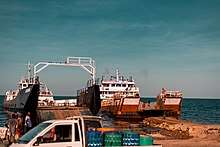
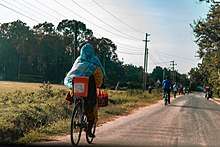
Port
In 2013, a large two berth intermodal container deepwater port terminal was proposed by Tanzanian government. Called Bagamoyo Port, it will be constructed at Mbegani, near Bagamoyo.[11] China planned to invest US$10B to make Bagamoyo the most important port in Africa by 2017.[12][13]
In 2018, the project got the go ahead and work started in about June/July. It will be built in association with the state-owned China Merchants Port, it will include a special economic zone. The US$ 10bn project is backed by an Omani sovereign wealth fund.[10][14][15]
In 2019 Tanzanian President John Magufuli announced the suspension of the project.[16]
Public transport
Bagamoyo is served by the Bagamoyo Daladala stand near Bagamoyo road south east of Bagamoyo.
Notable inhabitants
- Sewa Haji Paroo, 19th century businessman of Indian origin
- Julian Scherner, German Nazi Party official and a high-ranking member in the SS
- Hukwe Zawose, Tanzanian traditional musician
Twin towns and sister cities
Gallery
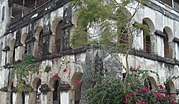 The Mission Building
The Mission Building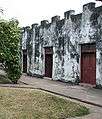 German garrison
German garrison- The Old Church
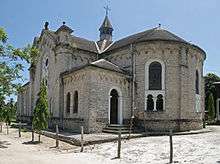 The second church built by the missioners
The second church built by the missioners
See also
References
- "Towns and Cities Near Bagamoyo (Zanzibar Urban) - Within 40 Miles Distance of Bagamoyo Zanzibar Urban Tanzania Between 0 and 64.36 Kilometers Radius List". www.distantias.com. Retrieved Sep 22, 2019.
- "Bagamoyo - Kaole Ruins". Archived from the original on 16 July 2010.
- Fabian, Steven (2013). "East Africa's Gorée: slave trade and slave tourism in Bagamoyo, Tanzania". Canadian Journal of African Studies. 41:1: 95–114. doi:10.1080/00083968.2013.771422.
- Rockel, Stephen (2009). "Slavery and Freedom in the Nineteenth Century East Africa: The Case of Waungwana Caravan Porters". African Studies. 68:1: 87–109. doi:10.1080/00020180902827464.
- Hill-Yates, Erica Alane (2012). "What's in a Tale?: Slavery, Memory and the Intersections of Race, Class and Gender in Coastal Tanzania". Race, Gender & Class. 19 (1/2): 336–352. ISSN 1082-8354. JSTOR 43496877.
- "The Central Slave and Ivory Trade Route". UNESCO World Heritage Centre. Retrieved 2019-10-29.
- Stanley, H.M., 1899, Through the Dark Continent, London: G. Newnes, ISBN 0486256677
- Wynne-Jones, Stephanie; LaViolette, Adria. The Swahili World. London. ISBN 978-1-315-69145-9. OCLC 994591960.
- "Cross-Cultural Solutions". Retrieved 1 October 2012.
- Mead, Nick Van (July 31, 2018). "China in Africa: win-win development, or a new colonialism?". The Guardian. Retrieved September 22, 2019.
- "Green light for new Tanzanian port". 2010-12-13. Archived from the original on 2014-11-07. Retrieved 2013-10-14.
- "Tanzania and China sign port development package". Archived from the original on 2016-03-04. Retrieved 2013-10-14.
- "Tanzania / Africa / Forums / Railpage". railpage.com.au. Railpage Australia. Archived from the original on 2014-11-07.
- Anyango, Anita (Jul 23, 2018). "Africa's seaports: A catalyst for growth". Retrieved Sep 22, 2019.
- "Construction of Tanzania's Bagamoyo port to start in June: minister - Xinhua | English.news.cn". www.xinhuanet.com. Retrieved Sep 22, 2019.
- "Tanzania Suspends $10B Bagamoyo Port Project". Retrieved 26 June 2019.
- "Vallejo Sister City". Vallejo Sister City Association. Archived from the original on 2013-09-11. Retrieved 2013-09-11.